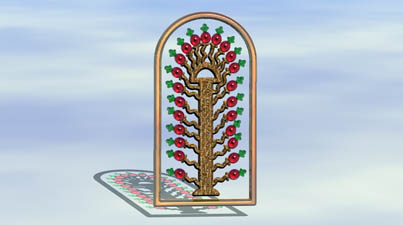
Watchers. Vanites. Adamites.
The lattice pattern is an abstract rendering of the branches in the Sumerian Tree. It becomes a more definite pattern in the Babylonian and Assyrian Tree. In the vine tree style each branch becomes a single extension from the core ending in a fruit.
The cosmic pole is the trunk of the Tree. This pole became the staff of the caduceus and the axis mundi of the World Pillar.
The bell jar shape is one of the distinctive features of the Tree. It shows up in all Mesopotamian cultures and in the Harappan culture of the Indus Valley. It does not, however, appear as such in Egyptian renderings.
The Tree always has fruit or foliage. The fruit is usually rather large and plump and sometimes looking like a pine cone . The fruit as a pine cone was its most popular depiction even unto the Greeks and Romans.
When looking at the five images of the Tree we can see the shared elements:
1 Sumerian: Genii, Pole, Lattice, Bell shape, Fruit and not shown but above the solar winged disk
2 Babylonian/Assyrian: Genii, Pole, Lattice, Bell shape, Foliage and not shown but above the solar winged disk
3 Urartian: Genii, Pole, Bell shape and Fruit
4 Indus Valley: Bell shape, Foliage and the god in the tree
5 Labeled Sumerian but much more likely Assyrian: Genii (King), Pole, Lattice, Bell shape/god in the tree, Fruit and the god as the solar winged disk
One other surprising element is the "god within" the tree from the Indus Valley. In the Osiris legend, Osiris an Egyptian god murdered by his brother Set and within a coffin is tossed into the Mediterranean when on the shores of Phoenicia he becomes encased within a tree. Also as the axis mundi which is another Tree of Life symbol the king is the tree (as in the interpretation of Nebuchadnezzar's dream - "That tree, O king, is you" Daniel 4:10-22). In the Indus Valley the pipal tree is linked to Krishna. For in the Bhagavad Gita, he says,"Among trees I am the ashvattha" - pipal in Sanskrit.
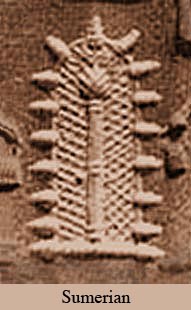
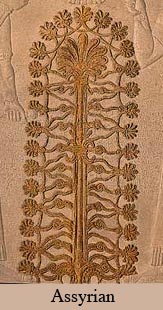
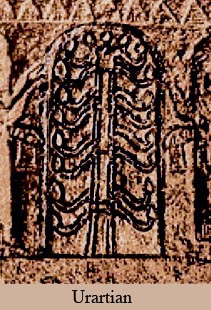
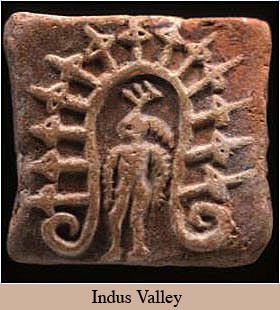
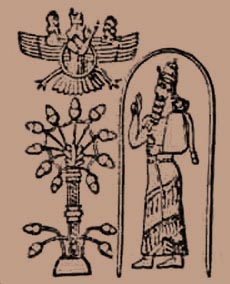 The
illustration to the left is Assyrian. The genii or more
likely the king
is within a bell shape. The tree displays the fruit, lattice
and
cosmic pole. The solar winged disk of Assyria floats above.
The
illustration to the left is Assyrian. The genii or more
likely the king
is within a bell shape. The tree displays the fruit, lattice
and
cosmic pole. The solar winged disk of Assyria floats above. The bell shape surrounding the tree may have influenced the conical shape of the omphalos stones of Greece and elsewhere. This shape is manifested in the Shiva lingua of Hinduism whose birthplace has been credited to the Indus Valley. What the bell shape of the Tree of Life represents is a matter of speculation. It may be iconic of glowing or shining as in The Shining Ones or an emanating life force. A tree that glowed would mean it would have bioluminescence like a firefly. The Mayans believed that it did have some type radiating power or force. Whatever it represents it is an important feature depicting the Tree of Life.



 As
archaeologists look at these images of the genii,
they have speculated that the cone shaped fruit is a sponge for the
purpose of sprinkling holy water on the tree, a type of ritual
cleansing. The fruit is sometimes called a pine cone as it sometimes
has been depicted by the artists of their time. The picture farthest to
the left shows the fruit as this so-called pine cone. We know that the genii is
picking the fruit of
immortality to put into his
pouch. The illustration second to the left is an example of the
stylized
vine-tree rendering of the Tree of Life. It clearly shows the fruit
drawn as a pine cone. The next pictures is from India and was labeled
maize. It too is another example of the fruit from East Indian art.
Also note the rosette design on both wrist bracelets
which is also associated with the Tree of Life - yet another sacred
symbol.
If
you look at the shape of the fruit it is almost always in a football or
oval shape. Sometimes the "fleur" is also attached (which in the
fleur-de-lys the center shape is also of this elongated
shape).
As
archaeologists look at these images of the genii,
they have speculated that the cone shaped fruit is a sponge for the
purpose of sprinkling holy water on the tree, a type of ritual
cleansing. The fruit is sometimes called a pine cone as it sometimes
has been depicted by the artists of their time. The picture farthest to
the left shows the fruit as this so-called pine cone. We know that the genii is
picking the fruit of
immortality to put into his
pouch. The illustration second to the left is an example of the
stylized
vine-tree rendering of the Tree of Life. It clearly shows the fruit
drawn as a pine cone. The next pictures is from India and was labeled
maize. It too is another example of the fruit from East Indian art.
Also note the rosette design on both wrist bracelets
which is also associated with the Tree of Life - yet another sacred
symbol.
If
you look at the shape of the fruit it is almost always in a football or
oval shape. Sometimes the "fleur" is also attached (which in the
fleur-de-lys the center shape is also of this elongated
shape).
The legend of the Tree of Life and it's fruit of immortality can be seen in the legends of other cultures. In ancient Greece there is the story of the Hesperides, three guardian nymphs who protect a tree in a garden that grows golden apples of immortality. Also in this garden is a dragon which is another symbol of the serpent. In Norse mythology Idun is the keeper of the apples of immortality. What we know of Norse mythology is from Icelandic manuscripts. In one Sumerian legend Inanna and Dumuzi had fruit trees and one of them was an apple tree.
"My
well-stocked garden
of the plain,
My barley
growing high in its furrow,
My apple
tree which bears fruit up to its crown,
He is
lettuce planted by the water."
It is not hard to notice that most of the time there seems to be two figures tending the tree. There were two personalities that protected and were sustained by the tree and, of course, they would be Van and his modified human companion Amadon. The image of the Tree of Life persisted with kings attending to it. In fact the tree is associated with superhuman kingship. In some depictions of the tree the guardians are eagle headed genii although some call this representation a hawk. The term griffin is sometimes used to describe these guardians.
“The
heavenly origin of kingship is already attested in the earliest
Mesopotamian cultures ["When the kingship was lowered from heaven the
kingship was in Eridu"]. In both Sumerian and Babylonian mythology, it
is expressed allegorically with the image of a tree planted upon earth
by the mother goddess, Inanna/Ishtar. The sacred tree, usually
represented in the form of a stylized palm tree growing on a mountain,
is the most common decorative motif in Assyrian royal iconography. It
occurs in imperial architecture, on seals and weapons of the ruling
elite, on royal jewelry and elsewhere. The walls of the palace of king
Ashurnasirpal II (883-859 B.C.) in Kalhu (modern Nimrud) were covered
with more than 400 representations of the sacred tree.”
(http://www.bib-arch.org/bswb_AO/bswbao0604kprdg3.html)
(http://www.gatewaystobabylon.com/introduction/sonsofgod.htm)
There is a description of King Solomon building his House of the Lord in I Kings chapter 6. I Kings 6:1 "He carved all the walls of the house round about with carved figures of cherubim and palm trees and open flowers, in the inner and outer rooms." In other verses it is stated the cherubim are a pair and on the doors they and the tree are covered in gold. This theme of the tree with the cherubim is repeated throughout the temple many time over.





The French symbol of royalty to the far left is known as the Fleur-de-lys. It originated with the first of the Merovingian kings of France. This symbol comes out of Sumeria and is directly related to the Tree of Life. It can be traced all the way back to the Sumerian god Enki. In the image second from the left he is holding a pot of flowing waters with the symbol above it. This is also a maritime symbol which always indicates north. The next illustration is from Urartu which clearly shows the fluer attached to the fruit. Next is a Phoenician drawing of the Tree of Life. Notice the fleur at the center top. This is a style known as the vortical tree as is the following Assyrian tree. The final example of the fleur is from a piece of metal work from Urartu. It dons the helmet of a genii. The Fleur-de-lys has been so widely used that it is considered classical.

 Rosette
RosetteThen we have the rosette. It too is a symbol connected to the Tree of Life. It has eight spoke-like leaves just like the symbol for the sun god Shamash. Standard rosette design with center dark pit to the far left. Next is Urartian metal work with a band of rosettes. The last image is from a Sumerian seal showing rosette's connection to the tree. This symbol is closely associated with the goddess Inanna and of course to the Tree of Life. This is a pan-Mesopotamian symbol.
"The rosette was the most common decorative “temple symbol” throughout the ancient lands, prevalent in Mesopotamia, Western Asia, Anatolia, Crete and Greece. It is an accepted view that the rosette as a temple symbol was an outgrowth of a celestial phenomenon. (A sun circled by its satellites), or solar eclipses." (http://www.strayreality.com/Lanis_Strayreality/where_did_they_come_from.htm)
The rational for the rosette being derived from a solar phenomenon is due to interpretation of Paleolithic rock paintings and petroglyphs. These are some of the first images made by early man.
"In the present essay we have documented that glaring anomalies distinguish the earliest iconography associated with the various celestial bodies. Prehistoric petroglyphs from around the world consistently portray the ancient sun-god in a fashion that bears little resemblance to the appearance of the current solar orb. Among the most common petroglyphs are those which show the solar disc equipped with a central dot, an eight-spoked body, a rosette, and a pillar-like appendage. The fact that the very same images appear amongst the earliest pictographs in Sumeria, Egypt, and Mesoamerica not only confirms the stubborn longevity of these sacred images, it offers some justification for the view that a continuity of beliefs (e.g. astral worship) likewise underlies the common images, thereby offering hope of discovering the original significance of the prehistoric petroglyphs upon analysis of their historical counterparts." (http://www.kronia.com/library/journals/rockart.txt)
The
Inanna Connection
"The cuneiform tablets of
Sumer display eight-pointed impressions made thousands of years ago by
a stylus pushed into wet clay, and we know today that these
eight-pointed impressions signify Inanna, Goddess of Morning and
Evening. It seems fitting that the impressions of this ancient written
language bring to mind images of both flower-like rosettes and pointed
stars, for images that capture both the intensity of a star and the
subtle delicacies of a flower reflect well the Goddess' paradoxical
nature. In this alone, Inanna is like Kali, the Hindu goddess often
called "Mother of the Universe" or "The Divine Mother", as Kali's
magical diagram, or yantra, contains the eight-petaled lotus. Further,
Inanna's powers as a goddess with her command of both the life-giving
and life-taking aspects of the universe, in addition to the physical
proximity of the Tigris and Euphrates rivers to the Indus Valley, tells
us that Inanna and Kali are related not by coincidence, but by a direct
tie of the Sumerian to the early Indian cultures."
(http://www.maabatakali.org/inanna.htm)
"The eight-point rosette has long been identified as a symbol of Sumer's Inanna, dating back at least 5300 years before present [Figures 1-2]. The iconographic link between Inanna and the eight-point rosette was already well established by 3000 BCE.13 The rosette was incorporated into game boards as early as those excavated from the Royal Tombs of Sumer [Figure 3], circa 3000-2600 BCE.14" (http://www.goddesschess.com/chessays/janigk.html)
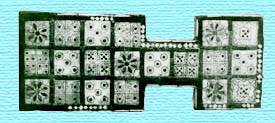 Game board
Figure 3
Game board
Figure 3
The subtitle of Watchers, Vanites and Adamites refers to those celestials who were able to benefit from the Tree of Life and as the Sumerian records show all three in some way were connected to this tree. The Watchers (or as the Anunnaki) were connected to it through Dilmun the garden of the gods where no one grew old. The Vanites through Enki and the Adamites were connected through Inanna.
 The Tre of Life and
the Ancients
The Tre of Life and
the Ancients